LED bulbs are gaining popularity and are replacing classic incandescent bulbs due to their durability and economy. A large selection of shapes and sizes allows you to diversify the interior. The power of LED lamps differs from that of Ilyich's lamps. To choose a replacement, it is necessary to clarify some data and compare with the table of ratios.
- Description and characteristics
- LED lamp power
- Calculation of the power of LED lamps for the home
- Comparison of the wattage of LED lamps with other light sources
- Comparison with incandescent bulbs
- Comparison with halogen lamps
- Comparison with fluorescent light sources
- Reasons for Differences
- Producers' gimmicks
Description and characteristics
Main characteristics of LED lamps:
- Light flow... The average is 100 lm / 1 W. Bulbs give out from 250 to 2500 lumens.
- Light temperature from 2700 to 6400 Kelvin (cold, daylight, warm light).
- Scattering anglefrom 60 to 340 °.
- Light transmission index up to 100 Ra.
- Energy efficiency class A, A +, A ++.
- Power consumption from 3 to 30 watts.
- Rated voltage 220 volt.
- Operating temperature range from -10 to + 40 °.
- Life time from 30 to 50 thousand hours.
Conventional lamps are produced with plinths E27 and E14. For luminaires designed for a voltage of 12 volts, types GU4, GU5.3, GU10 are used.
You can choose the most different shapes and sizes... Before buying, you should measure the diameter and height of the plafond so that the bulb will fit into it.

LED lamp power
When changing bulbs, consider power matching incandescent and LED luminous flux... The characteristics are measured in the same quantities. To navigate the indicators and correctly translate the values, you can be guided by the following table of ratios.
| Ilyich's light bulb (W) | LEDs (W) | flux (lm) - approximate value |
| 20 | 2-3 | 250 |
| 40 | 4-5 | 400 |
| 60 | 8-10 | 700 |
| 75 | 10-12 | 900 |
| 100 | 12-15 | 1200 |
| 150 | 18-20 | 1800 |
| 200 | 25-30 | 2500 |
For example, a 60 W incandescent lamp corresponds to a 7 W LED lamp - so that the conversion is correct, they are guided by the data on the packageThe presented values indicate one of the main advantages of LEDs - economic benefit.

Calculation of the power of LED lamps for the home
- natural light level - BUT;
- area premises (rooms, for example) - B;
- general number of lighting fixtures - FROM;
- luminous flux - D.
To count light flow, I use the formula: D = A * B / C. Illumination level is calculated as follows: A = C * D / B.
For each square meter, it is necessary to determine the location of the lamps in the room in order to capture the entire space. At the same time, the efficiency of LEDs is maximum in corner radius of 120 °.
Comparison of the wattage of LED lamps with other light sources
Before replacing bulbs, you must explore general characteristics. Comparing the pros and cons will help you find the right model. Durability, brightness, power LED luminaires differ from incandescent and fluorescent lamps. Lamps are mainly used in the dark, so it is advisable that the light be soft - usually choose warm, yellowish. Such light comes from the classic products of Ilyich, but they do not differ in a long service life. Other characteristics are also important.
Comparison with incandescent bulbs
Heat transfer is an equally important characteristic. Glass classic products heats up to 170-250 ° Celsius... Therefore, they are considered the most fire hazardous; installation in wooden houses is not recommended. Maximum heating temperature LEDs - 50 ° Celsius.
Lifetime unequal and is one of the main reasons for replacement. According to the manufacturer, LED bulbs work for about 30-35 thousand hours under the correct conditions of use.
Efficiency - coefficient of efficiency is an indicator that shows how much of the consumed electricity is converted into light and how much into heat. LEDs the indicator is the highest and is equal to 90%, for incandescent lamps - only 7-9%.
Comparison with halogen lamps
Low efficiency -15%... Electricity is spent on heating and maintaining the glow. Average service life is 2000 hours... The indicator directly depends on the frequency of switching on. In some cases, installation of additional equipment is required - special dimmerswhich provide smooth shifting and extend service life.
Comparison with fluorescent light sources
The LEDs also contain a phosphor that covers the crystals. Under the influence of current, a semiconductor glows, the color is always blue.
The main difference is efficiency value... LEDs do not use additional elements, so the indicator of these products is always higher.
Reasons for Differences
The differences between the lamps are due to the structure of the devices. Ilyich's lamp works by heating the tungsten filament, the glow turns yellow. Lamps of the latest generation have a different approach - light is formed after the activation of various chemical compounds (phosphor).
An additional advantage is that technology allows you to receive light of different shades (daytime, warm, cold)... Different base / plinth diameters allow you to quickly select the best option for replacement.
Producers' gimmicks
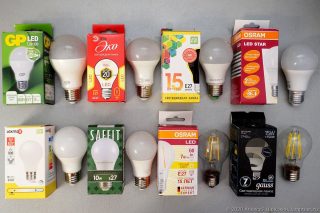
In recent years, the production of light bulbs has grown, and some characteristics have changed. For example, in 2014, a 10 watt lamp produced a luminous flux of 1000 lm... Products 2012-2013 have indicators of no more than 700-800... Manufacturers prefer not to mention such nuances. Those should be chosen for which the flow value is higher (indicated on the package, measured in lm).
The service life marked on the factory boxes is overestimated. In addition to the period of service indicate overestimated luminous flux values... For example, one manufacturer indicates indicators of 8 W and 650 lm, and another - 8 W 1000 lm. In the second case, the numbers are exaggerated.
Another situation is understatement... This means that a power of 5 W can be indicated, but in fact a 7 or 8 W light bulb. Electricity consumption is high, and the efficiency is much lower. Such situations can be avoided if purchase bulbs at points of sale that have already been verified... You can read reviews on the Internet, check with friends.

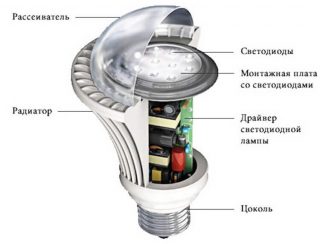

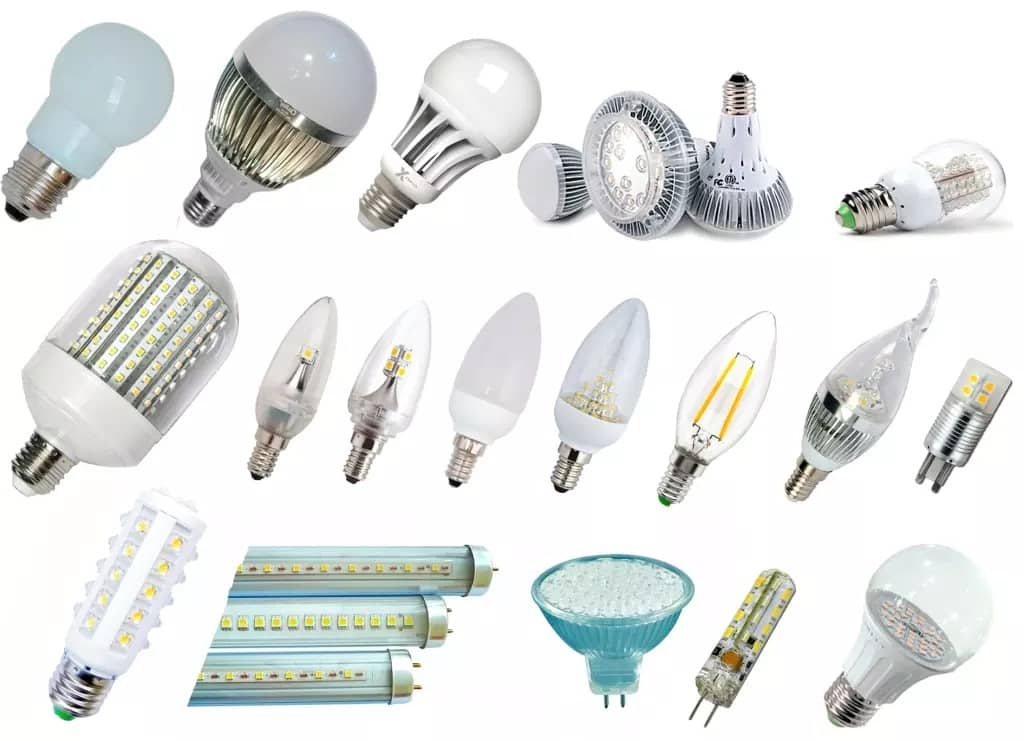
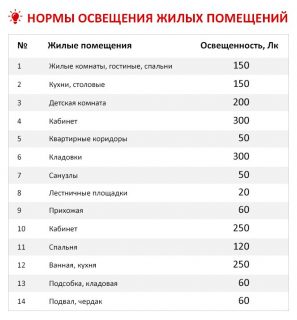
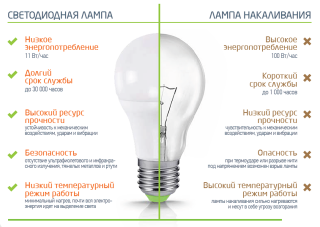
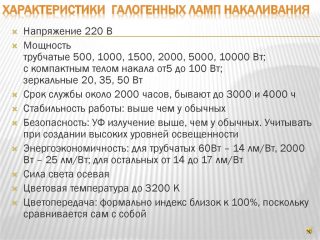
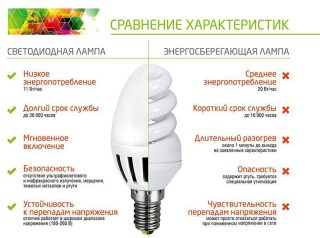








Incandescent lamps have the same efficiency as a steam locomotive
Everything is so and not so. On the face of the usual conspiracy. I am an energy engineer and I know for sure that with the advent of new light sources, old good and normal incandescent bulbs began to be produced deliberately by none. And the new ones, even in terms of service life, often do not reach the old ones. Well, if you calculate the ratio of the price of a new lamp + the price of electricity, then in the end it turns out that the good old incandescent light bulb wins. Because, in fact, new bulbs burn like straw, not reaching the promised 30,000 or 50,000 hours (which corresponds to about 25-40 years of operation), even 1,500 hours
The actual efficiency of LED lamps is close to the efficiency of fluorescent lamps or not much higher. For fluorescent lamps, the power must be multiplied by about 5, for LED lamps by about 6, in order to obtain the equivalent power of the incandescent lamp. While for compact fluorescent lamps, the characteristics are reported relatively honestly, for LED lamps, manufacturers overestimate both power consumption and efficiency. If it is written that a 10 W LED lamp is equivalent to a 100 W incandescent lamp, then in fact this usually means about 8 and 50 watts. The lifespan of LED lamps usually does not exceed the lifespan of fluorescent lamps, while LED lamps are more expensive or lower wattage.
90% - they flattered themselves. It is difficult to assess the efficiency of lamps. I will go from the opposite. A 10W lamp with an efficiency of 90% should give 1W to heating. But knowing the dimensions and its temperature, operating conditions, I can say with 20% accuracy - the bulb heats up with 5 watts. So 50% of the strength.